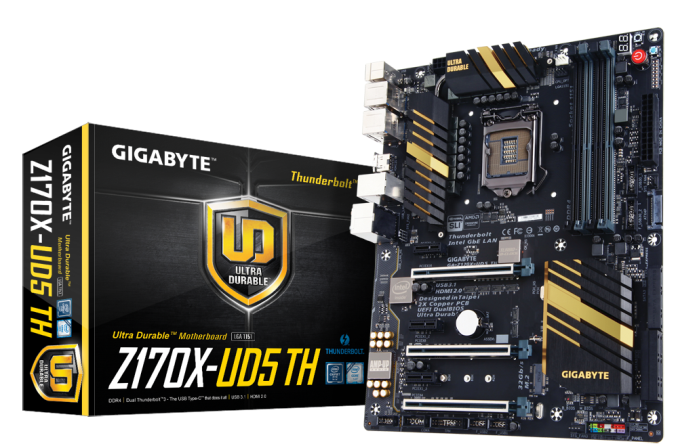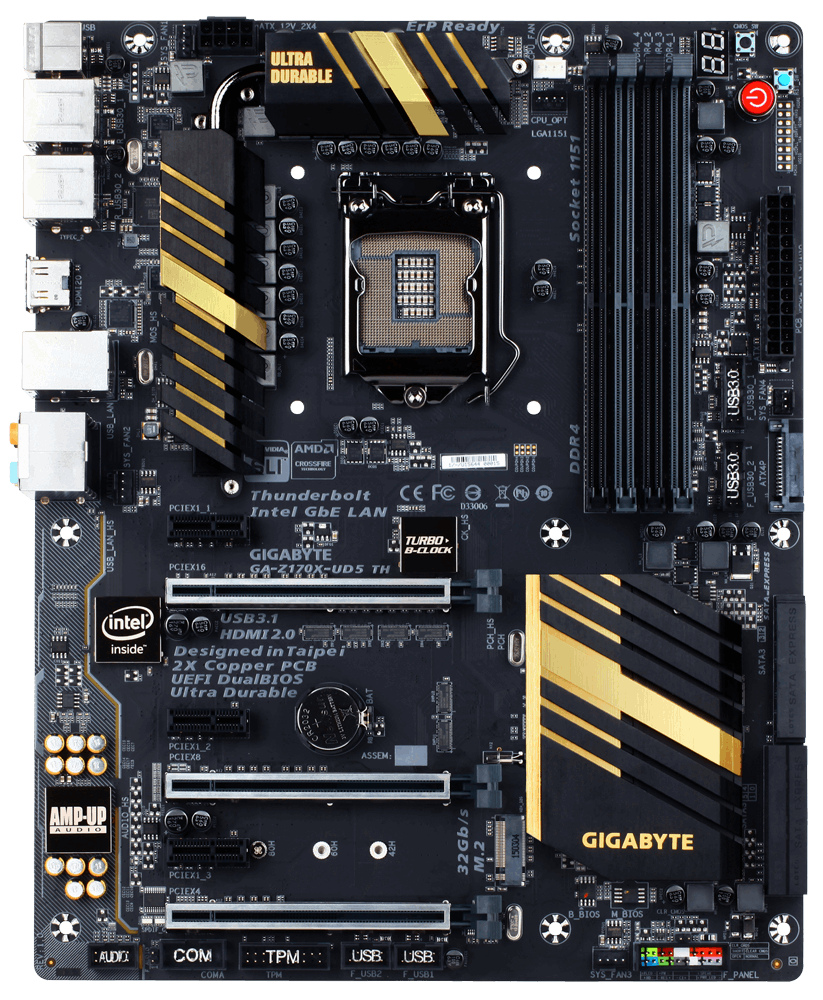The GIGABYTE Z170X-UD5 TH Motherboard Review: An Entry to Thunderbolt 3
by Ian Cutress on February 19, 2016 9:00 AM EST- Posted in
- Motherboards
- Gigabyte
- Thunderbolt
- Skylake
- Z170
- Thunderbolt 3
The Thunderbolt 3 Bandwagon
One of the main reasons why some users buy certain motherboards is due to a specific feature. If you need to use a specific feature that only some models have, it guts out 98% of potential candidates at the first step. Typically most users will separate by compatibility and price first if they don’t need a certain specific feature, but it means that when we look for Thunderbolt 3 enabled motherboards, the Z170X-UD5 TH comes in at one of the cheapest models available and only $6 more than the non-Thunderbolt 3 variant.
As can be the issue with early adoption though is the lack of devices currently using the standard. We saw similar issue with the previous two generations of Thunderbolt, especially when it came to Windows compatibility (most devices ended up focused on Apple), or things like SATA Express that never took off. Perhaps SATAe is an odd-ball standard anyway, but it still stands to reason that TB3 devices are thin on the ground. Standard expectations will put it on the next generation MacBook Pro and Mac Pro devices, as well a display or two, but we are going to have to wait for other storage/hub options to come through. There’s also the issue of cabling – TB3 requires an active cable to reach 40 Gbps, whereas a cheaper passive cable will only be rated for 20 Gbps. Nonetheless, it comes back to that $6 difference; if you can use the ports for USB 3.1 in the meantime, then it can make it an easy decision to spend the extra for the price of a large double-shot coffee.
Moving away from the Thunderbolt 3 aspect and we have GIGABYTE’s main stream Ultra Durable brand motherboard sitting between the UD3 and UD7. This means it gets the UD black/gold branding, some upgraded power delivery, GIGABYTE’s new PCIe protection guard scheme to avoid slots being ripped out by large cards and storage options in M.2. The UD5 TH is also one of the few motherboards that will support HDMI 2.0 (HDCP 2.2), in this case using a LSPcon, when the integrated graphics are in play. It seems a little odd to be upgrading the integrated graphics options with a motherboard aimed at discrete GPU users, however GIGABYTE clearly sees a benefit here when non-GPU PCIe devices are in use instead.
There’s also some upgraded Realtek ALC1150 audio using PCB separation, filter caps and EMI shielding, with RGB LEDs underneath the motherboard on the digital side for users that want to pimp their rig. There’s another interesting choice in using an EMI shield for the Intel I219-V network controller, as this tends to make little difference in performance. There’s also the three SATA Express ports, but the only thing that can use them that is for sale is a USB 3.1 front panel bay which of course, sells separately.
In the performance metrics, the Z170X-UD5 TH does use MultiCore Turbo, but only on certain benchmarks – we saw video encoding and 7-Zip encoding were MCT enabled, but WinRAR encoding and ray tracing were not. This gave the performance a mid-range outing between those that do enable MCT and those that do not. For the system benchmarks, idle power and POST time were the best we’ve seen so far on Skylake, but load-to-idle delta and DPC Latency were nothing to write home about. GIGABYTE also implements their classic mode BIOS only here, avoiding the HD mode altogether, but the software package is easier to use and update than previous generations.
For users interested in water cooling, it is worth noting that EKWB has a CPU plus power delivery water block available for the Z170X-UD5 TH using G1/4 fittings at €118. For some of the markets that GIGABYTE aims for, having tie-ins with extra hardware manufacturers can be a good thing, especially for users wanting to expand designs beyond a simple cooler and memory.
There are a few oddities, such as HDMI 2.0 on a GPU focused motherboard, having three SATAe ports but no SATAe drives in the market, and having the M.2 slot muxed with the final PCIe slot rather than having them separate as is possible with the Z170 chipset. The first two of those most users will ignore anyway, but there is certainly an element of design here that warrants the price point. The GIGABYTE Z170X-UD5 TH is a good motherboard by most metrics. I have since handed it off to Ganesh to update one of his NAS/Thunderbolt testing systems, as it was one I had that would fit the bill. The board is one of the most appealing to those wanting to invest in Thunderbolt 3, as and when devices enter the market - especially if it is still only $6 more than the non-TH version, and that will most likely be the biggest draw.












29 Comments
View All Comments
romrunning - Friday, February 19, 2016 - link
Hey, for your "Quick Board Feature Comparison", why didn't you include the feature that is right in your article's title - you know, Thunderbolt 3? It's a pain to compare the other boards when I don't know if they have TB3 or not.extide - Monday, February 22, 2016 - link
He did, although, to be fair, you need to know that having the Intel Alpine Ridge controller listed under USB3.1 implies TB3.romrunning - Wednesday, February 24, 2016 - link
To be clear, I would like to know if the other boards being compared specifically support TB3 so that it's more of an apples-to-apples comparison.Having the Alpine Ridge controller doesn't guarantee the board supports TB3. For example, the Asus Maximus VIII Impact doesn't support TB3. Perhaps this is some type of limitation for mini-ITX boards w/AR controllers; I know the Gigabyte Z170N Gaming 5 has the AR controller but doesn't support TB3. Maybe this is an artificial limit imposed by the mfg, or maybe this is just a limitation of how much circuitry you can stuff into the smaller size.
pikunsia - Thursday, August 4, 2016 - link
Hey romrunning, look at thishttps://en.wikipedia.org/wiki/Thunderbolt_(interfa...
DanNeely - Friday, February 19, 2016 - link
Where did all the assorted surface mount parts that normally cover the area between the PCIe slots and elsewhere on the board go to give it the cleaner surface look?extide - Monday, February 22, 2016 - link
They probably put a lot of them on the back. Lots of boards have been doing this recently, I have noticed. A lot of what they clean up is actually not so much components, but excess silk-screen.RazrLeaf - Friday, February 19, 2016 - link
From the images, it looks like the motherboard has 2-packs of 2 SATA cables, so 4 total.tspacie - Friday, February 19, 2016 - link
Is anyone doing TB on a small motherboard? I don't need the fast, external port if I have a bunch of PCIe slots and room for extra disks.romrunning - Friday, February 19, 2016 - link
Small, mini-ITX boards only have the 1 PCIe slot. So that fast TB3 port certainly helps if you need it.alamilla - Friday, February 19, 2016 - link
Although Thunderbolt is hardly a mainstream protocol (yet) it is big in the audio and video production industry for it's incredibly low latency.With this Skylake offering and the recently released X99P-SLI, I'm optimistic Gigabyte will release a Thunderbolt enabled mATX or ITX board for Broadwell-E.